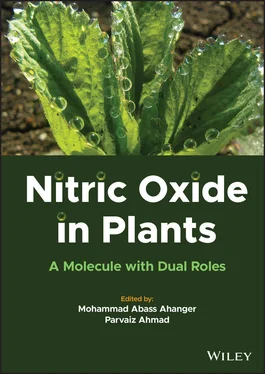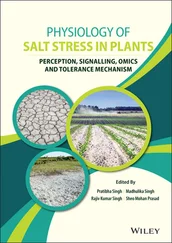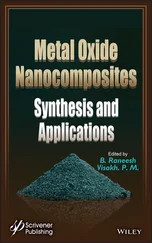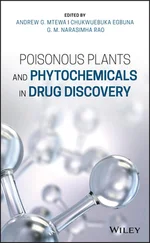Nitric Oxide in Plants
Здесь есть возможность читать онлайн «Nitric Oxide in Plants» — ознакомительный отрывок электронной книги совершенно бесплатно, а после прочтения отрывка купить полную версию. В некоторых случаях можно слушать аудио, скачать через торрент в формате fb2 и присутствует краткое содержание. Жанр: unrecognised, на английском языке. Описание произведения, (предисловие) а так же отзывы посетителей доступны на портале библиотеки ЛибКат.
- Название:Nitric Oxide in Plants
- Автор:
- Жанр:
- Год:неизвестен
- ISBN:нет данных
- Рейтинг книги:5 / 5. Голосов: 1
-
Избранное:Добавить в избранное
- Отзывы:
-
Ваша оценка:
- 100
- 1
- 2
- 3
- 4
- 5
Nitric Oxide in Plants: краткое содержание, описание и аннотация
Предлагаем к чтению аннотацию, описание, краткое содержание или предисловие (зависит от того, что написал сам автор книги «Nitric Oxide in Plants»). Если вы не нашли необходимую информацию о книге — напишите в комментариях, мы постараемся отыскать её.
Examines the beneficial roles of nitric oxide in growth and stress tolerance regulation through its involvement in tolerance mechanisms Nitric Oxide in Plants: A Molecule with Dual Roles
Nitric Oxide in Plants: A Molecule with Dual Roles
Nitric Oxide in Plants — читать онлайн ознакомительный отрывок
Ниже представлен текст книги, разбитый по страницам. Система сохранения места последней прочитанной страницы, позволяет с удобством читать онлайн бесплатно книгу «Nitric Oxide in Plants», без необходимости каждый раз заново искать на чём Вы остановились. Поставьте закладку, и сможете в любой момент перейти на страницу, на которой закончили чтение.
Интервал:
Закладка:
2.2.3 Nonenzymatic Synthesis of NO
In addition to enzymatic methods, a nonenzymatic pathway for the production of NO from NO 2has been reported. This sort of NO production is favored by low pH, e.g., in the apoplast of the growing seeds, where NO can be released from a protonated form of NO 2, i.e., nitrous acid (HNO 2). Another possible mechanism is the release of NO from S -nitrosoglutathione (GSNO). In the peroxisomes, both NO and the NO-derived peroxynitrite can interact with glutathione to synthesize GSNO (Neill et al. 2003; Courtois et al. 2008; Wilson et al. 2008; Palavan-Unsal and Arisan 2009).
2.3 NO Signaling and Gene Regulation Under Abiotic Stress
In animals, NO is involved in the regulation and the expression of different genes related to several different pathways, either directly by interacting with receptors involved in the signal transduction pathway, or indirectly by moderating the activity of transcription factors, or influencing the stability and translation of messenger RNA (mRNA) (Kolbert et al. 2021). Recently, a protein named “AtNOS1” exhibiting NOS activity has been recognized. This protein belongs to the NOS family (a novel family) and displays some similarity to previously reported mammalian NOS. It consists of a guanosine-5′-triphosphate (GTP)-binding domain and may have GTPase activity (Li et al. 2020). AtNOS1 activity is highly dependent upon Ca 2+-calmodulin/NADPH −; however, it is independent of FAD, FMN, and BH4. Studies have provided a genetic basis for a role of AtNOS1 as a source of NO in abscisic acid (ABA)-induced closure of stomata, in the suppression of flowering, and the defense responses induced by lipopolysaccharides (Wang et al. 2020). Under abiotic stress, ABA production is the key stress response in plants. The signaling between ABA and NO governs the major molecular mechanisms that incorporate external signals to modify internal systems leading to plant adaptations against stress (Falak et al. 2021). NO interacts with ABA to modulate the gene expression and the protein function. For example, ABA prevents water loss through stomatal closure and contributes to the synthesis of osmolytes. It has been observed that in the guard cells of Arabidopsis thaliana , ABA increases H 2O 2production, which in turn regulates the production of NO, which subsequently regulates the stomatal closure (Li et al. 2020; Wang et al. 2020; Falak et al. 2021).
Salicylic acid (SA) is another organic plant compound that contributes to the modulation of seed germination, vegetative defense, and response to changing environment. The association between NO and the non-expressors of pathogenesis-related proteins, i.e. NPR1 , NPR3 , and NPR4 (SA receptor genes), is well recognized for plant defense (Prakash et al. 2021). These NPR proteins regulate various transcription factors (TFs) and endure posttranslational changes (modulated by SA). S -nitrosylation of NPR proteins modifies NO signaling through oligomerization of NPR (Falak et al. 2021; Prakash et al. 2021). NO also controls the expression of NPR1 during plant defense. In Arabidopsis , the SA-dependent defense response has been shown to be triggered by NO. For instance, the application of the NO donor “GSNO” ( S -nitrosoglutathione) enhanced the expression of NPR1 and its analogous protein, which subsequently improved the SA content and induced PR genes, conferring resistance against Pseudomonas . Moreover, a rapid change in the levels of glutathione, which is important for the activation of NPR1 and accumulation of SA, has been induced by NO (Fatima et al. 2021; Hediji et al. 2021; Kaur et al. 2021).
2.4 Role of NO in Metabolic and Developmental Pathways
NO has been shown to play an important role in the modulation of various physiological processes of plants mentioned in Table 2.1. Some of those processes include germination of seed and pollen, plant growth and development, closing and opening of stomata, senescence, flower development, and fruit ripening (Kopyra 2004; Delledonne 2005; Wilson et al. 2008). NO was documented to induce germination in light-dependent Arabidopsis and lettuce seeds, which indicates that NO takes part in root development (Li et al. 2016). Various NO donors stimulated root tip enlargement of Zea mays , in a dosage-related mode, and its length was prohibited by a NO scavenger (methylene blue) (Kopyra 2004). It has been proposed that NO and indole-3-acetic acid share some common steps in cell signaling, as they both stimulate the same plant response. Various studies have been suggested that stress regulates the endogenous levels of indole-3-acetic acid. As well as root growth and development, NO was found to be involved in the development and realignment of pollen tubes, best studied in A. thaliana (Pagnussat et al. 2003, 2004). It has been reported that NO has also been involved in the synthesis of several biological constituents including saponin and phytoalexin (Pagnussat et al. 2003, 2004).
Table 2.1 Role of nitric oxide (NO) during abiotic stress.
| Abiotic stress | NO-mediated effect | Plant species | Reference |
| Drought | Abscisic acid signaling and closure of stomata | Pisum sativum | Syed Nabi et al. 2019 |
| Salt | Increased tolerance of root growth | Oryza sativa Nicotiana tabacum | van Zelm et al. 2020 |
| Heavy metals | Heightened response in terms of root growth and oxidative stress | Lupinus Chlorella vulgaris | Solórzano et al. 2020 |
| Temperature | Release of NO and increased tolerance of seedlings | Oryza sativa Nicotiana tabacum | Syed Nabi et al. 2019 |
| Ultraviolet radiation | Nitric oxide synthase activity | Arabidopsis thaliana | Tossi et al. 2009 |
Plants have established multifaceted innate/induced and hypersensitive mechanisms (HR) to protect themselves from pathogenic microorganisms, which subsequently terminate in systemic acquired resistance (SAR). An initial significant event is the elevation of Ca 2+by using the plasma membrane cyclic nucleotide-gated ion channels (CNGCs). This is consistent with a role for cyclic guanosine monophosphate (cGMP) in plants, and various putative guanylate cyclase activity proteins including phytosulfokine receptor (PSKR). In PSKR, the cytosolic guanylate cyclase domain is activated by its biologically active ligand, a sulfonated phytosulfokine. An increase in Ca 2+triggers the creation of SA, NO, and reactive oxygen species (ROS), which stimulates apoptosis in the proximity of the infection, thereby restraining pathogen progression (Heath 2000; Mur et al. 2019; Noman et al. 2020).
2.5 Role of NO in Overcoming Abiotic Stress
Plants are static creatures confined to the particular place where the seed sprouts. During its life cycle, a plant experiences a diverse and changing environment. With time, plants have established various mechanisms to handle the different kinds of stress environments. Although stresses are numerous, plant’s reactions commonly comprise similar components and signaling pathways. NO is an important constituent in numerous plant acclimation responses to biotic and abiotic strains (Figure 2.2) (Verma et al. 2016; Nowicka et al. 2018; Gong et al. 2020). The response mechanisms for NO signaling are generally similar for all types of stresses. Figure 2.3 contains details of the NO signaling pathway to scavenge ROS during different abiotic stresses.
Читать дальшеИнтервал:
Закладка:
Похожие книги на «Nitric Oxide in Plants»
Представляем Вашему вниманию похожие книги на «Nitric Oxide in Plants» списком для выбора. Мы отобрали схожую по названию и смыслу литературу в надежде предоставить читателям больше вариантов отыскать новые, интересные, ещё непрочитанные произведения.
Обсуждение, отзывы о книге «Nitric Oxide in Plants» и просто собственные мнения читателей. Оставьте ваши комментарии, напишите, что Вы думаете о произведении, его смысле или главных героях. Укажите что конкретно понравилось, а что нет, и почему Вы так считаете.












